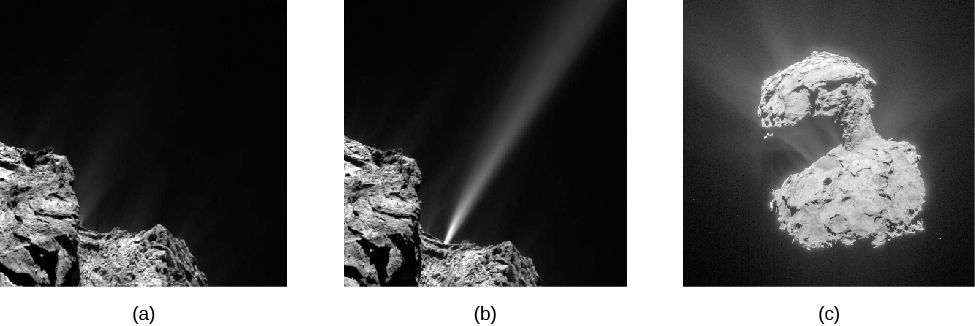| << Chapter < Page | Chapter >> Page > |
The Rosetta mission was launched in 2004. Delays with the launch rocket caused it to miss its original target comet, so an alternate destination was picked, Comet Churyumov-Gerasimenko (named after the two discoverers, but generally denoted 67P). This comet’s period of revolution is 6.45 years, making it a Jupiter-family comet.
Since the European Space Agency did not have access to the plutonium-fueled nuclear power sources used by NASA for deep space missions, Rosetta had to be solar powered, requiring especially large solar panels. Even these were not enough to keep the craft operating as it matched orbits with 67P near the comet’s aphelion. The only solution was to turn off all the spacecraft systems and let it coast for several years toward the Sun, out of contact with controllers on Earth until solar energy was stronger. The success of the mission depended on an automatic timer to turn the power back on as it neared the Sun. Fortunately, this strategy worked.
In August 2014, Rosetta began a gradual approach to the comet nucleus, which is a strangely misshapen object about 5 kilometers across, quite different from the smooth appearance of Halley’s nucleus (but equally dark). Its rotation period is 12 hours. On November 12, 2014, the Philae lander was dropped, descending slowly for 7 hours before gently hitting the surface. It bounced and rolled, coming to rest under an overhang where there was not enough sunlight to keep its batteries charged. After operating for a few hours and sending data back to the orbiter, Philae went silent. The main Rosetta spacecraft continued operations, however, as the level of comet activity increased, with steamers of gas jetting from the surface. As the comet approached perihelion in September 2015, the spacecraft backed off to ensure its safety.
The extent of the Rosetta images (and data from other instruments) far exceeds anything astronomers had seen before from a comet. The best imaging resolution was nearly a factor of 100 greater than in the best Halley images. At this scale, the comet appears surprisingly rough, with sharp angles, deep pits, and overhangs ( [link] ).

The double-lobed shape of 67P’s nucleus has been tentatively attributed to the collision and merger of two independent comet nuclei long ago. The spacecraft verified that the comet’s dark surface was covered with organic carbon-rich compounds, mixed with sulfides and iron-nickel grains. 67P has an average density of only 0.5 g/cm 3 (recall water in these units has a density of 1 g/cm 3 .) This low density indicates that the comet is quite porous, that is, there is a large amount of empty space among its materials.
We already knew that the evaporation of comet ices was sporadic and limited to small jets, but in comet 67P, this was carried to an extreme. At any one time, more than 99% of the surface is inactive. The active vents are only a few meters across, with the material confined to narrow jets that persist for just a few minutes ( [link] ). The level of activity is strongly dependent on solar heating, and between July and August 2015, it increased by a factor of 10. Isotopic analysis of deuterium in the water ejected by the comet shows that it is different from the water found on Earth. Thus, apparently comets like 67P did not contribute to the origin of our oceans or the water in our bodies, as some scientists had thought.

The European Space Agency is continuing to make interesting short videos illustrating the challenges and results of the Rosetta and Philae missions. For example, watch “ Rosetta ’s Moment in the Sun” to see some of the images of the comet generating plumes of gas and dust and hear about some of the dangers an active comet poses for the spacecraft.
Halley first showed that some comets are on closed orbits and return periodically to swing around the Sun. The heart of a comet is its nucleus, a few kilometers in diameter and composed of volatiles (primarily frozen H 2 O) and solids (including both silicates and carbonaceous materials). Whipple first suggested this “dirty snowball” model in 1950; it has been confirmed by spacecraft studies of several comets. As the nucleus approaches the Sun, its volatiles evaporate (perhaps in localized jets or explosions) to form the comet’s head or atmosphere, which escapes at about 1 kilometer per second. The atmosphere streams away from the Sun to form a long tail. The ESA Rosetta mission to Comet P67 (Churyumov-Gerasimenko) has greatly increased our knowledge of the nature of the nucleus and of the process by which comets release water and other volatiles when heated by sunlight.

Notification Switch
Would you like to follow the 'Astronomy' conversation and receive update notifications?